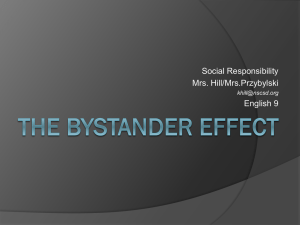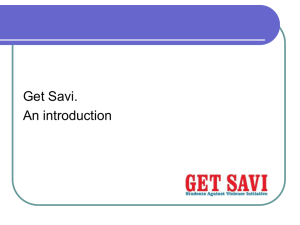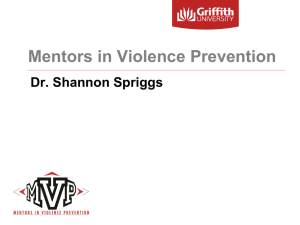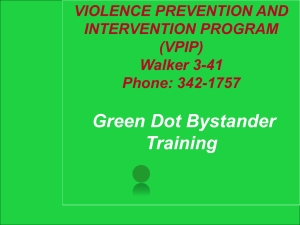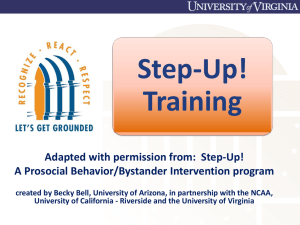Day 2: Victoria Banyard, PhD
advertisement
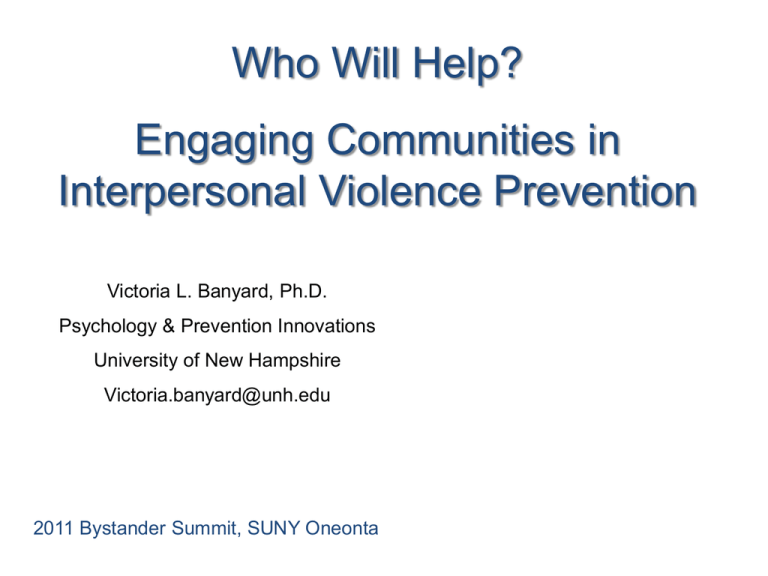
Who Will Help? Engaging Communities in Interpersonal Violence Prevention Victoria L. Banyard, Ph.D. Psychology & Prevention Innovations University of New Hampshire Victoria.banyard@unh.edu 2011 Bystander Summit, SUNY Oneonta Overview • Translating bystander research into prevention • Formative evaluation: Lessons Learned – Implementation – Diffusion of innovation • Outcome evaluation: Does it work? How do we promote positive bystander intervention? Notice event + need for help Empathy Assume responsibility Social Norms Pros and cons including safety Perceived efficacy Skill set + experience Choose from options Provide help Adapted from Latane and Darley and Dovidio. AWARENESS/KNOWLEDGE • Need to notice risk factors • Need to define the situation as problematic • Perceived susceptibility and severity (Health Belief Model) • Cues to action (HBM) • Asked to intervene • Community specific stories, examples, data RESPONSIBILITY • Characteristics of the bystander • Perceptions of the victim – Victim empathy – In-group versus out-group status • Social norms – Against sexual violence – In favor of intervention (TPB) • Being asked (cues to action) • Characteristics of the situation • Diffusion and facilitation PROS/CONS/PERSONAL SAFETY • Health behavior theories support decision process for new behaviors – weigh pros and cons • Bystander research also shows cost/benefit analysis • Safety nets for bystanders • Social norms to support helpful intervention • Audience inhibition (Berkowitz) CONFIDENCE AND SKILLS FOR ACTION • Increase confidence/efficacy • Need specific skill building • Need role models (POLS research) • Need range of options (MVP program) • Beliefs about outcomes (TPB) Empirical Support for the Situational Model: Studies of Bystander Behavior and Relationship Violence Attitudes Beta 0.3 0.2 0.1 *** *** ** * ** 0 -0.1 -0.2 Beta -0.3 -0.4 -0.5 -0.6 -0.7 *** Banyard, V. L. (2008). Measurement and correlates of pro-social bystander behavior: The case of interpersonal violence. Violence and Victims, 23, 83-97. Broader Bystander Behaviors Longitudinal Predictors of Behavior: Attitudes matter *** Banyard, V. L. (2008). Measurement and correlates of pro-social bystander behavior: The case of interpersonal violence. Violence and Victims, 23, 83-97. Complexities • Gender • Age • Who is helped? – Friends versus strangers – Victims versus perpetrators • Typology of helping • Which models better predict behavior? • Environmental contexts (e.g. community size; sense of community) Theories of Health Behavior Change: Lessons from Prevention • Parallels – Readiness for Change process – Key variables from Social/cog model, TPB, HBM: • • • • • Knowledge Personal attitudes and Peer norms Confidence/efficacy Beliefs about outcomes (pros and cons) Behavioral intention Founding Bystander Programs • Founding Programs: – Jackson Katz – Mentors in Violence Prevention (MVP) – Alan Berkowitz • Recent Programs – Bringing in the Bystander (UNH) – Foubert – The Men’s Program – Edwards - SEEDS • Theater Programs – InterACT – California State University – No Zebras – Central Michigan – iScream – Rutgers - McMahon Shared components • Use of discussion and active learning • Visualization exercises – build empathy – Connect material to participants’ felt experience • Practice scenerios – Model and practice skills – Practice applying to own experience • Increase awareness – Debunk myths – Provide information to reduce ambiguity • Directly ask people to play a role • Need for evaluation data Bringing in the Bystander ™ • Social marketing campaign (Potter & Stapleton) • In-person educational workshop (Moynihan, Eckstein, Banyard) © University of New Hampshire The Program: Specific content • What is a bystander? • Victim empathy • Defining scope of sexual violence – causes and consequences – Consent 101 • Range of safe interventions for bystanders – Modeling range of skills – Reviewing community resources • Emphasis on bystander safety • Pledge to intervene • Bystander plan A Local Example: Stoke Hall Gang Rape 1987 • Three men gang raped a woman in 1987 in Stoke Hall, a residence hall at UNH. • The victim transferred to another University. • Two of three offenders plead guilty to misdemeanor sexual assault for which they would each spend 2 months in prison. Small Group Work Ask participants to: • • • • • think of examples when they did or did not intervene think of examples when they saw someone else intervene think of examples when someone intervened on their behalf discuss and list the reasons they did or did not intervene share how they felt about their experiences, what impact it had on them • discuss if it is easier or more difficult to intervene when it’s a friend or a stranger, and why? Responsibility BYSTANDER PLEDGE I pledge to Express my outrage about rape and all forms of sexual violence. Talk to other community members about sexual violence. Interrupt sexist jokes that objectify women and girls. Seek information about why sexual violence is so prevalent in our society and how I can help prevent it. Change anything I may be doing that contributes to sexual violence. Support and encourage men and women to take responsibility for ending sexual violence. Listen to my friends’ and partners’ fears and concerns for safety. Pay attention to cries for help and take action. Challenge images of violence against women in advertising and entertainment. Support women and men working together to end sexual violence. Nurture myself and be aware of my personal safety. Believe and support women, children, and men who have experienced any form of sexual violence. _____________________________________ Name and Date _____________________________________ Witness and Date Decision making process Decision Making Process QUESTIONS TO ASK BEFORE I TAKE ACTION: • Am I aware there is a problem or risky situation? • Do I recognize someone needs help? • Do I see others and myself as part of the solution? QUESTIONS TO ASK DURING THE SITUATION: • How can I keep myself safe? • What are my available options? • Are there others I may call upon for help? • What are the benefits/costs for taking action? DECISION TO TAKE ACTION: • When to act? • Resources: people, phone, etc available? • ACT Close up Least safe With others Alone Most safe Distant NUMBERS TO CALL Emergency or Police 911 Sexual Harassment and Rape Prevention Program 862-SAFE (7233) (SHARPP) New Hampshire Statewide Toll Free Hotlines 1-866-644-3574 (Domestic Violence) 1-800-277-5570 (Sexual Assault) For more information about Bringing in the Bystander contact www.unh.edu/preventioninnovations prevention.innovations@unh.edu QUESTIONS TO ASK BEFORE I TAKE ACTION Am I aware there is a problem or risky situation? Do I recognize someone needs help? Do I see others and myself as part of the solution? QUESTIONS TO ASK DURING THE SITUATION How can I keep myself safe? What are my available options? Are there others I may call upon for help? What are the benefits/costs for taking action? DECISION TO TAKE ACTION When to act? Are resources available (people, phone, information)? ACT The ABCs of Intervention “Active Bystanders Care” Assess for safety. Be with others. Care for victim. Bringing In the BystanderTM A Prevention Workshop for Establishing a Community of Responsibility © Plante, Banyard, Moynihan, Eckstein HOW TO INTERVENE SAFELY Call police or someone else in authority. Tell another person. Being with others is a good idea when a situation looks dangerous. Yell for help. Ask a friend in a potentially dangerous situation if he/she wants to leave and then make sure that he/she gets home safely. Ask a victim if he/she is okay. Provide options and a listening ear. Call the local crisis center for support and options. See telephone numbers on the back of this card. SCENARIO THREE: You are walking down the hall to catch the elevator to go to your room. When you pass a dorm room on the first floor you hear a man and a woman yelling at each other. The man is calling the woman a “slut” and other names. Decision Making Process: People have arguments all the time…is this my business? Have they been drinking?…I wonder if this argument will escalate and someone is at risk of being physically hurt…will someone else call the police if it continues?…should I go get my RA? What am I supposed to do? Pros and cons of each option: Nothing. It is none of my business. Go to my room and come down in an hour to see if they are still “going at it.” Go get my RA and discuss it with her/him. Call 911. Your own idea:_____________________________________ What do you do? How do you stay safe? * Format adapted with permission from Katz, Mentors in Violence Prevention PERSONAL PLAN OF ACTION SCENARIO:____________________________________ _______________________ DECISION MAKING PROCESS:___________________________________ __ PLAN OF ACTION:____________________________________ ________ _____________________________________________ ___________________________ Stages of Change • Denial and precontemplation: lower efficacy and higher rape myth acceptance, cons outweigh pros • Contemplation: greater knowledge, intent, confidence, pros outweigh cons • Action: greater helping and confidence (cost/benefit not significant) Rape Myth Acceptance Decisional Balance Experimental Evaluation Experimental evaluation 3 conditions Control One-session treatment Three-session treatment Longitudinal design Part of this project was supported by Grant No. 2202-WG-BX-0009 awarded by the National Institute of Justice, Office of Justice Programs, U.S. Dept. of Justice. Points of view in this presentation are those of the authors and do not necessarily represent the official position or policies of the U.S. Dept. of Justice Participants 389 undergraduates (172 men ; 217 women) Exclusionary criteria: participants excluded if not traditional college age and if had received prior training as peer advisor or advocate at sexual assault crisis center. Retention rate 75-94% Outcomes • Knowledge • Efficacy • Attitudes –Rape myth acceptance –Willingness to help –Pros and cons of being a bystander • Self-reported bystander behavior Hypothesis: Program will be effective • Repeated measures using measure of social desirability as covariate across 3 time points (pre-, post-, 2 mo). – Significant time x group interaction • No gender differences in program effects • Some persistence of effects at 4 and 12 months Banyard et al (2007). Sexual violence prevention through bystander education: An experimental evaluation. Journal of Community Psychology, 35, 463-481. Knowledge Helping Intention Decisional balance: Total Bystander Behaviors Percentage improving by at least 1 SD Percentage worsening by at least 1 SD Next Steps CDC grant • • • • 2 campuses Cohort Effects Social marketing as booster for program Community surveys Collaboration with Residential Life • Who helps? An ecological model – Intrapersonal: women, first year students; those who spend less time drinking, watching TV and videogames, those who study more, prosocial tendencies – Interactional: Higher floor sense of community; Higher campus sense of community; Those involved in student orgs – Exosystem: size of living situation Context and Behavior Acknowledgements Mary Moynihan, UNH Jane Stapleton, UNH Sharyn Potter, UNH Bobby Eckstein, UNH Mary Mayhew and the staff of SHARPP Angela Borges Our Umass Lowell partners: Linda Williams, Alison Cares, Mary Frederick Elizabethe Plante Grace Mattern and the NH Coalition Against Domestic and Sexual Violence Our teams of graduate and undergraduate peer educators and research assistants. UNH Office of Residential Life Research participants who gave their time to the projects
